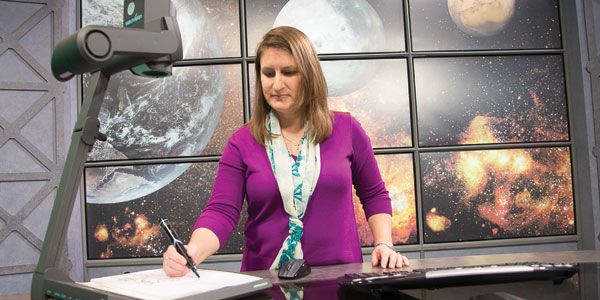Alumni Profile

Kimberly Hall Brush '96, Ph.D., with NASA's Langley Research Center, helps students discover the wider realm of engineering and envision careers in science that match their skills.
A Teaching Job That's Out of This World
by Sally Dixon
It all started with astronaut Sally Ride.
The first American woman to enter space visited the eighth-grade classroom of Kimberly Hall Brush ’96, and Brush realized then that traditionally male-dominated jobs in science and math, and teaching—which she had always wanted to do—weren’t mutually exclusive.
Her major in philosophy at Nazareth proved to be the ideal foundation for what was to become her dream job. “The philosophy program taught me how to think, not what to think. And Nazareth has a phenomenal teaching program,” says Brush, whose concentrations were in elementary and special education. “This was at a time when education was very scripted, and I rebelled against that form of teaching. Nazareth gave me an open mind, so when the opportunity arrived to come to NASA, I saw it as the perfect place to be.”
Since June 2013, Brush has worked as Educator Professional Development Coordinator at NASA’s Langley Research Center in Hampton, Virginia, a civilian job she was offered after completing a 15-month Pathways internship program at Langley and her doctorate in Educational Policy, Planning, and Leadership at the College of William and Mary. Her dissertation research was on women in engineering and how an internship affects persistence in getting into the field.
Early in 2012, “NASA contacted one of my advisors to recommend someone for help with an education research project,” says Brush. “I interviewed for it, but instead of the three-month project, I was asked to apply to the Pathways Program.” Pathways programs provide opportunities for students and recent graduates to be considered for federal employment.
Brush’s Pathways program involved leading an evaluation of the 26-year-old Langley Aerospace Research Student Scholars Program (LARSS) to see where former interns had gone after their internship. The research revealed that 80 percent of LARRS participants went on to STEM (science, technology, engineering, and math) careers, quite a bit higher than the national average. She also learned there were certain assumptions about NASA people that weren’t true—for example, that they were all from Ivy League schools. In fact, people who work for NASA come from two- and four-year colleges and universities and are matched to jobs based on a wide-ranging assortment of factors.
Now her pet project, which she identified during her Pathways research, is to tell “gatekeepers”—guidance counselors and other advisors who influence students’ academic and career choices—more about what engineers actually do. “I worked in special education a long time, and I wanted to bring clarity to what engineering is and isn’t, especially for kids who don’t fit the ‘calculus’ model,” says Brush. “These kids have hands-on skills and shouldn’t be passed aside for careers in math and science. They’re so important to our future workforce.”
She’s setting up daylong workshops throughout Virginia, each involving local engineers in all disciplines, to help advise students, parents, and teachers. Her goal: to enable connections that last more than a day and to further students’ interests in STEM. Among other projects, Brush is participating in a virtual professional development model for teachers and working with the Digital Learning Network (DLN) to connect classrooms with scientists and engineers. That’s in addition to coordinating radio and video “downlinks” between the International Space Station and two schools in her five-state region.
Most recently, Brush has been asked to help redefine education for the future at Langley. “This lets me connect with people across the center and gives me a stronger understanding of NASA as a whole, which is just an amazing place to work,” she says.
Sally Dixon is a freelance writer in Rochester, New York.